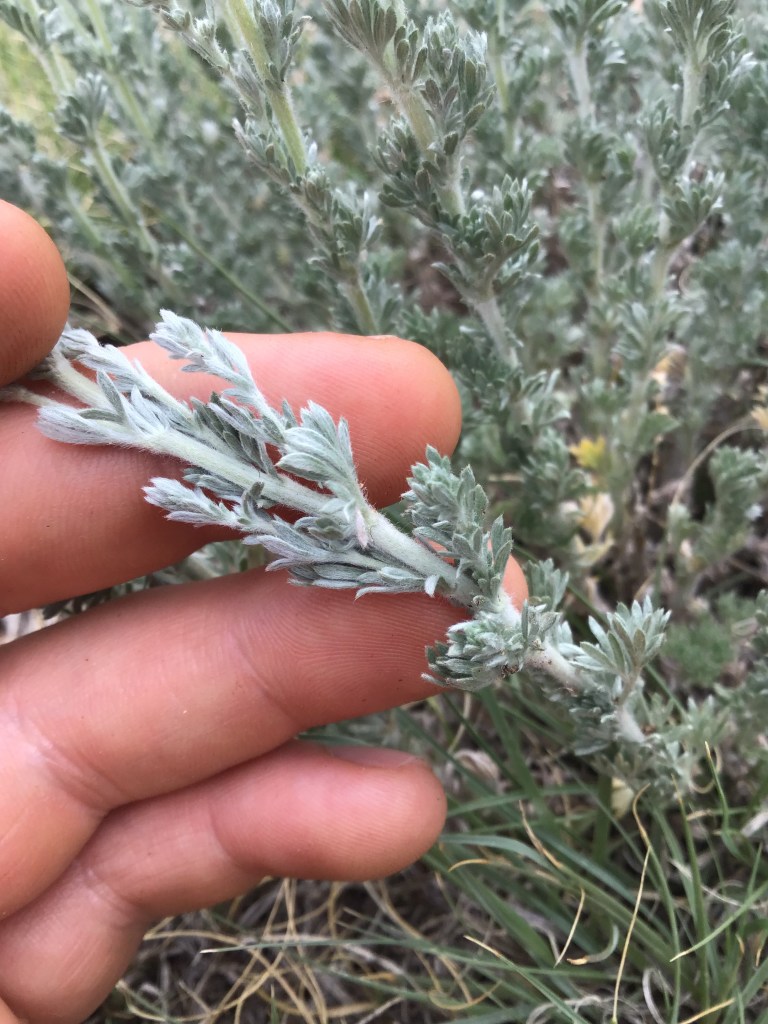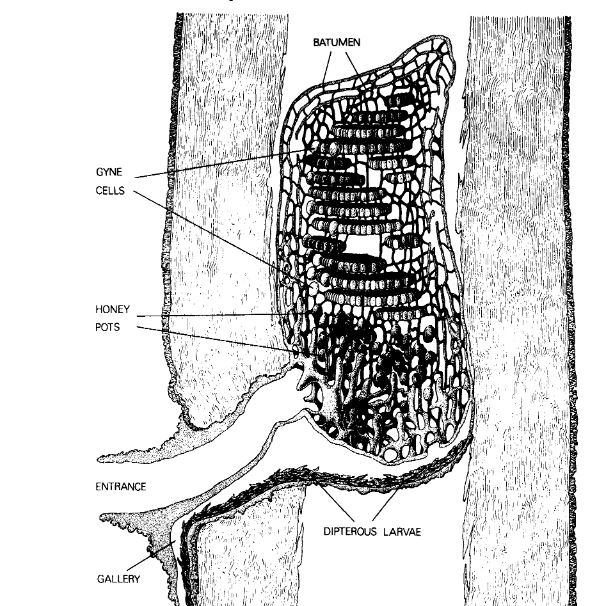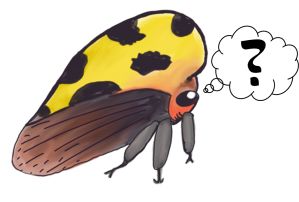This month, we got a pair of questions where people were asking about weird bees.
I was taking pictures of bees in my garden and I saw one that looked like it had a ball of cotton in its mouth. The white stuff was about the size of the bee’s head. Know anything about that type of thing? I can email pics if needed. Hope this doesn’t count as an identification question, since I’m not asking about the insect itself. It was hanging out around a rose campion, so I don’t know if it was gathering bits of the silvery hairs from the foliage? It seemed more interested in the foliage than the flowers.
Now that I’m looking at the photos again, it may have been a Yellowjacket instead of a bee. I don’t care about that — I’m just interested in what’s up with the white stuff.
-Curious about Bees, via email
Judges 14:8-10
-Solomon, via email
8 Some time later, when he went back to marry her, he turned aside to look at the lion’s carcass, and in it he saw a swarm of bees and some honey. 9 He scooped out the honey with his hands and ate as he went along. When he rejoined his parents, he gave them some, and they too ate it. But he did not tell them that he had taken the honey from the lion’s carcass.
This verse is from bible, from the book of Judges. I googled about a bee that actually converts dead body to honey. Can you throw some light on this? I am interested to learn about this. Thank you for your response.
We love weird bugs, so let’s just get into it. Straight-up.
Carder Bees
I was taking pictures of bees in my garden and I saw one that looked like it had a ball of cotton in its mouth. The white stuff was about the size of the bee’s head. Know anything about that type of thing? I can email pics if needed. Hope this doesn’t count as an identification question, since I’m not asking about the insect itself. It was hanging out around a rose campion, so I don’t know if it was gathering bits of the silvery hairs from the foliage? It seemed more interested in the foliage than the flowers.
Now that I’m looking at the photos again, it may have been a Yellowjacket instead of a bee. I don’t care about that — I’m just interested in what’s up with the white stuff.
So, this person is asking about a kind of bee called a carder bee.
This is a behavior that bees do to build nests. If you have a plant called lamb’s ear in your garden, you’ve probably noticed that they have a luxurious set of hairs on the leaves. Living here in Laramie, there’s a lot of plants which look similar. This sage, for example.

This sage is called Salvia apiana. It’s related to the sage you might have in your pantry; I use a similar plant to make sausage. Here in Wyoming, it’s considered a bit of a weed because I have to deal with it in my field trials. We’re pretty high up-well over a mile above sea level-so UV light is a pretty big concern for plants. To protect themselves, they grow a thick set of hairs over their leaves to block out some of the sunlight.
Normally, bees eat pollen and nectar…and carder bees do as well. However, bees also need to build nests. If you’re building a nest in a hollowed-out twig (or a hole you’ve chewed in a bag of soil, a situation I see on a regular basis), you need to shield your nest from the surroundings. Leaves work great for this. So do the hairs plants use to block UV light.
Most leaf-cutter bees use bits of leaves to do this. Some, however, use plant hairs. The most famous bee to use plant hairs is the European carder bee, Anthidium manicatum. Here in the US, it’s considered a bit of an invasive species because it competes with our native leaf-cutter bees for real estate.
It gets its name because it works similar to the machines used to spin wool into fabric. They scrape hairs from leaves, and turn them into a comfy nest lining…just like carders take hair from sheep and turn them into comfy nest linings. Well, clothes.
Vulture Bees
Judges 14:8-10
8 Some time later, when he went back to marry her, he turned aside to look at the lion’s carcass, and in it he saw a swarm of bees and some honey. 9 He scooped out the honey with his hands and ate as he went along. When he rejoined his parents, he gave them some, and they too ate it. But he did not tell them that he had taken the honey from the lion’s carcass.
This verse is from bible, from the book of Judges. I googled about a bee that actually converts dead body to honey. Can you throw some light on this? I am interested to learn about this. Thank you for your response.
This is actually a really cool story about why insect specimens don’t tell you much about the biology of insects.
The vulture bee, Trigona hypogea was described by Fillipo Silvestri at the turn of the century. When Silvestri was working on this group in 1902, he only had access to pinned specimens. So he described the species, mostly what it looked like well enough to tell it apart from other bees, and that was that for the next 80 years.
Silvestri has seen some nests, and described them as being used for honey and pollen. However, later workers noted that the nests did not contain pollen. They carefully dissected the nests, and examined everything under a microscope, and also did a biochemical workup. As far as anyone could tell, the nests all looked like they used secretions similar to the ones used to feed queen bees in honeybee nests.

The literature trail is kind of long and complex-this was a very difficult biological problem to solve and it was only solved in 1982-but through a lot of experiments, it was eventually discovered that Trigona hypogea and a few close relatives were finding meat, partially digesting it, and then using that as a high-protein material to feed their young.
They’ll lay down a pheromone trail which will attract other bees while repelling flies. This is a kind of social behavior. They’ll eat the meat, and can strip a corpse bare. They’ll partially digest the meat, and then use it as food for the young. This is virtually identical to how honey is produced. Only difference is that this is animal and not plant.
I have no idea what this honey would taste like…but it’s been reported to be quite good. I’m still going to discourage anyone from eating the stuff, I will speculate that it might be safe to eat because bees tend to incorporate antibacterial substances and critters (like yeasts) into their food. If you’ve eaten it, email us because I’m curious (although, again, it’s rotten meat. Not the best idea to eat.).
Returning to the original question, I don’t think these guys are described in The Bible, Koran or Torah. Just so everyone knows where I’m coming from, I am an Athiest. More PZ Myers than Christopher Hitchens, I don’t believe in any gods nor do I follow any religious text. However, I do recognize the value of religious texts as folk taxonomies which describe biological phenomena. I’ve written about how Salish legends were vital in discovering Rocky Mountian Spotted Fever, and how those same legends described biological phenomena which are still not adequately explained today.
That being said, I do think the observations in The Bible are true. To an extent.
Folks tend to not think of things as ‘bee-like’ unless they’ve got black and yellow striping. Visiting flowers and stinging are the two big things non-entomologists cue into when they think about bees, and there’s a lot of things which fit this bill. Trigona, however, doesn’t really resemble what you might think a bee looks like.
When I read this passage, my mind immediately goes to yellow jackets. They look and behave like bees. They visit flowers, but they’re also important scavengers. They feed their young with meat the same way honeybees feed their young with pollen. Trigona species-where the Vulture Bees are situated-are New World species. They only occur in South America, far away from where The Bible, Koran, and Torah were written. Thus, the folks who wrote these stories probably didn’t know about these critters.
However, Vespula has a lot of species which are found in the areas where these religions were founded. Thus, based on geography alone, they are a much better fit than Trigona for being responsible for the behavior found in this passage.
The Bottom Line
This is the time of year when people are bug-watching, much like people watch birds. It’s really cool to see people do this, and we’re honored to be the place people turn to when they have questions about bug behavior.
If you’re sitting in your garden and you see bees snipping bits off leaves, don’t worry. They’re supposed to be doing that, and they need to do that to create the next generation of pollinators.
People have been doing this for a long time, though.
Some of these observations are even preserved in religious texts. They don’t exactly match up with what we’ve discovered since then, but don’t count them out completely. The scavenging habits of wasps are documented, as are some weirder phenomena relating to disease transmission in the modern era.
Works Cited
CAMARGO, J. M., & ROUBIK, D. W. (1991). Systematics and bionomics of the apoid obligate necrophages: the Trigona hypogea group (Hymenoptera: Apidae; Meliponinae). Biological Journal of the Linnean Society, 44(1), 13-39.



I like a lot of your answer, but it gives me more questions. I understand your thought that folks don’t think “bee” unless there’s black/yellow & a sting. At least, I understand that for folks NOW. However, the other key item that makes people think “bee” is “honey.” And another thing about folks NOW is that they tend to discount folks from the past as being only partially correct or misguided. You propose that the “bees” at the carcass are wasps. What about the “honey” at the carcass? Is is an instance of bees just using a carcass as a place to make a nest? Basically, your yellowjacket theory only believes half of the story – “bees” but completely leaves out the other half, which is also the crux of the riddle – “honey.” What’s a theory that starts at “honey” and also includes “flying insects”?
LikeLike